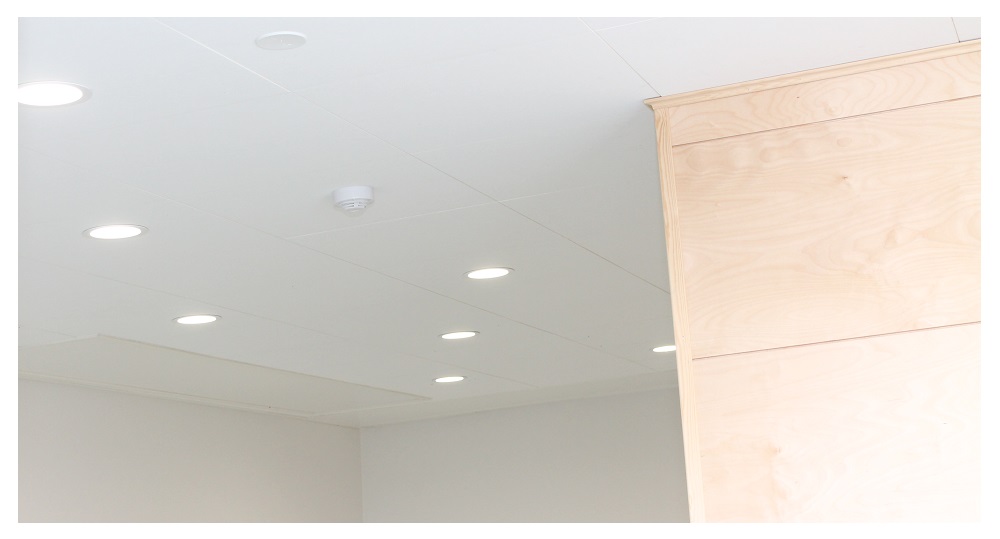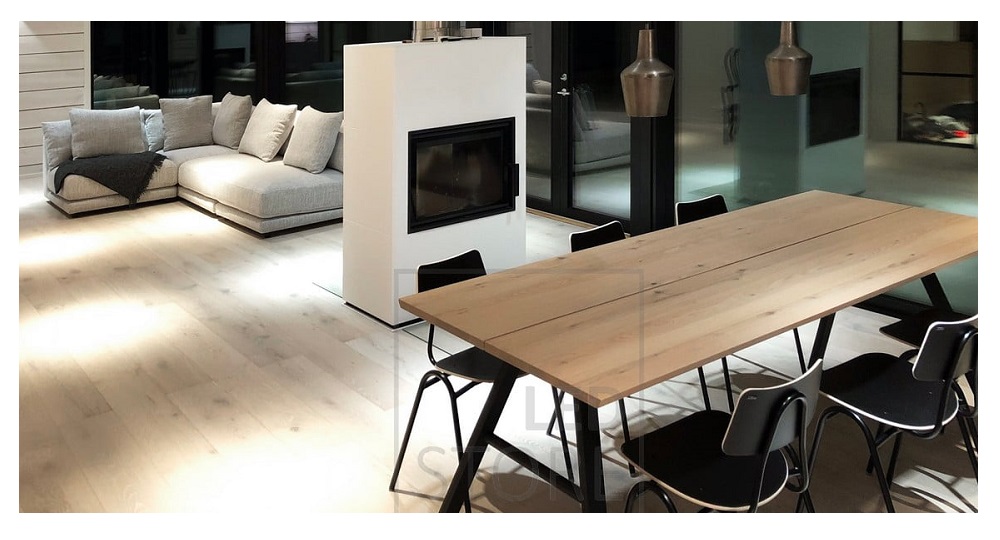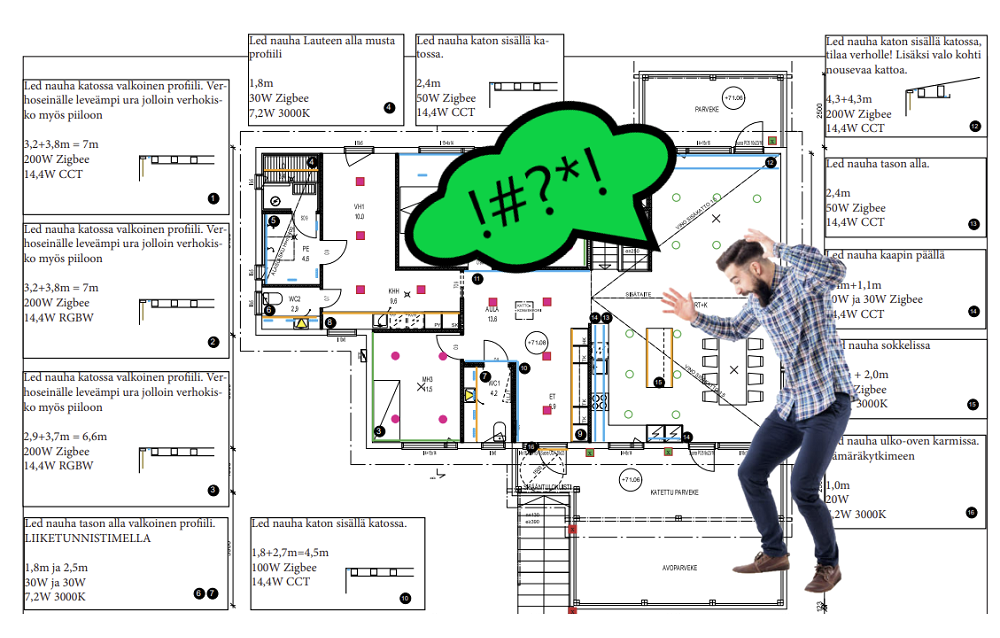Let’s address the mistakes in lighting design! The importance of lighting cannot be overemphasised when it comes to the atmosphere and comfort of a space. However, it is easy to make mistakes in lighting design that can compromise the user experience and aesthetics of a space. In this article, we will go through the most common pitfalls that many lighting designers have stumbled upon.
Lighting design mistakes – 10 most common mistakes:
1. Poor planning
The first mistake was the inadequate design of the lighting. It is important to take into account the needs and uses of different spaces. A comprehensive plan will help avoid excessive or inadequate lighting. In addition to general lighting, consideration should be given to space-specific lighting, such as a reading light next to a sofa.
A good design will have lighting in layers and allow for changes in space.
2. Disturbing shadows
Another common mistake in lighting design is distracting shadows caused by uneven lighting. This can be avoided by directing the light sources so that they are evenly distributed throughout the room. This greatly improves the comfort of the space and makes it easier to work in.
Occasionally you’ll come across situations where this is desirable and, if used correctly, light and shadow are nice to play with and can enhance the architecture. Choice of style.
3. Overuse of lights
A third mistake is the frequent overuse of light sources. Many people think that the more lamps, the better. However, this is not true, as too much light can be hard on the eyes and can spoil the atmosphere of a room. It is a good idea to adjust the amount of lighting according to the use of the space.
This rule applies in particular to spotlights, which can easily make a hole in the ceiling by accident.

4. Wrong light colour
In our list of lighting design mistakes, the fourth common mistake is using the wrong colour of light. Warm white light is generally the best choice for living spaces, while cool white light is better suited to working and commercial spaces. However, there is nothing wrong with using a cool or warm colour throughout the house, as long as the colour scheme of the interior matches.
The colour temperature should be chosen according to the purpose of the room to achieve pleasant and functional lighting. If you are not sure about the space or materials then always choose CCT adjustable lighting.
5. Neglecting energy efficiency
The fifth common mistake relates to a lack of energy efficiency. Today’s LED lights offer excellent luminous efficacy and long life, making them very energy-friendly options. So opt for energy-efficient solutions in your lighting design.

6. Poor adjustability
The sixth error concerns poor lighting adjustability. Flexibility is important so that you can adapt the lighting to the situation. Consider dimmable led lights or lighting control systems, which allow you to easily adjust the intensity of lighting and white light tones to suit your changing interior.
7. Designing only the interior
The seventh mistake on our list of lighting design mistakes is to focus lighting design only on interior spaces. Outdoor lighting is also important to improve safety and comfort. Remember to take into account outdoor lighting needs, such as lighting for walkways, terraces and courtyards.
This also applies to renovations where only a bathroom or bedroom is planned. The space to be designed must fit in with the overall design
8. Forgetting the plan
The eighth mistake was to leave the implementation of the lighting plan unfinished. The implementation of the lighting is as important as the design itself, so make sure that the lights and their installation are of high quality. Don’t compromise on quality, as this can compromise the functionality and durability of the lighting. If you omit lamps from the plan or replace them with half-power ones, the plan will not be implemented.
The situation is bad if the customer imagines that I will replace light X with model Y and the plan will come true. This is not necessarily the case, as the chosen light can have significant differences, such as colour rendering, opening angle or CCT adjustment, which affect the overall effect.
9. Too much target light
The ninth mistake is the excessive use of target lighting. While spotlighting is a good way to highlight certain areas or objects, excessive use can lead to confusing and uneven lighting. Use target lighting judiciously and focus primarily on general lighting. Spot lighting is therefore narrow-angle light.
Earlier it was mentioned that there is too much shadow, but of course if the client wants shadows, they can work, as in the picture:

10. Too late
The tenth and final mistake is starting the lighting design too late. Lighting design should start at the very beginning of the design process, so that you can take into account the lighting needs and installation possibilities. This avoids the need for retrofitting or structural modifications, which can be costly and time-consuming.
How to avoid lighting design mistakes
Recognising and avoiding these mistakes will help you design functional and comfortable lighting that enhances the user experience and creates the desired ambience.
A successful lighting plan takes into account the different uses of the space, the quantity and quality of lighting and energy efficiency. Good lighting can make a big difference to living comfort, working conditions and public spaces. So learn from these common mistakes and create the best possible lighting conditions in your space.
To avoid lighting design mistakes, lighting design should focus on careful planning, choosing the right light source and lighting adjustability. It is also important to consider both indoor and outdoor lighting and to ensure the energy efficiency of lighting solutions. This will help you avoid the most common mistakes and achieve a successful lighting plan.
Remember that good lighting does not happen by chance. It requires knowledge, skill and care. If you’re not sure about your own lighting design skills, consider hiring a professional. A lighting designer can take into account the different factors and help you find the best solutions for lighting both your home and public spaces.
Finally, remember that lighting design and implementation is an ongoing process. Technology is constantly evolving, and new innovations are coming to market. Keep up to date with developments in the lighting sector and adapt your lighting plan if necessary. So you can enjoy pleasant and functional lighting long into the future.
Led lighting expert
LedStore has been a specialist in Led lighting since 2010. We have our own product design, so our products are technologically state-of-the-art.
We focus on light colour temperature controlled and high colour rendering index lights. We do around 500 lighting designs in a year.
We offer a service of custom made led strips, i.e. custom made led light strips in profile. Also installed.
Remember that we are always ready to offer our help to you along the way, by email (myynti@ledstore.fi) and by phone (045 251 4510). As always, feel free to share photos of your own projects on social media at ledstore.fi at Instagram and ledstore.fi at Meta. We love to see the cool things done by our LEDs, and it also helps to provide inspiration for those who are not sure about the power and awesomeness of LEDs. Did you know that we already have over 3500 pictures of our LED installations in our Gallery!
Led Lights Gallery:
Product gallery: Pictures of products in different installation locations
Indirect light: Indirect light in different spaces
Room-specific: Light in different rooms
References: Complete houses that have been photographed

